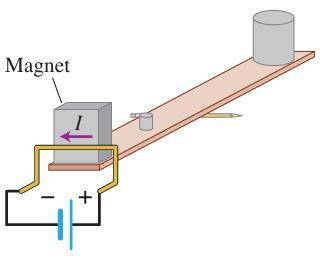
Physics, 22.02.2021 05:20 shanilafaridor97hl
You make a seesaw by placing a 50-g magnet (whose poles' faces are 2-cm-by-2-cm squares) at one end of a 50-cm-long ruler and a small 50-g metal object at the other end and balancing the whole setup by placing a pencil directly under the middle of the ruler. You know that the magnet is horizontally magnetized, but you don't know which face is north and which face is south. When you place a horizontal wire close to the pole of the magnet and send a 14-A current through the wire in the direction shown in (Figure 1), the end of the seesaw with the magnet goes up and the other end goes down. You can get the seesaw to go back to equilibrium (while keeping the current in the wire) by placing another 10-g metal object 3.0 cm from the axis of rotation, also shown in the figure.


Answers: 3


Another question on Physics

Physics, 22.06.2019 04:00
Which configuration would produce an electric current? a) rotate a coil of copper wire between two magnets. b) connect a wire between a copper and zinc strip sitting in a beaker of water. c) connect a wire to the (+) positive end of a battery and the other end to a light bulb. d) connect a wire to the negative end of a battery and the other end to a light bulb.
Answers: 2

Physics, 22.06.2019 13:40
Consider a double atwood machine constructed as follows: a mass 4m is suspended from a string that passes over a massless pulley on frictionless bearings. the other end of this string supports a second similar pulley, over which passes a second string supporting a mass of 3m at one end and m at the other. using two suitable generalized coordinates, set up the lagrangian and use the lagrange equations to find the acceleration of the mass 4m when the system is released. explain why the top pulley rotates even though it carries equal weights on each side.
Answers: 2

Physics, 22.06.2019 15:30
Identify the correct relation showing that the radius r of the orbit of a moon of a given planet can be determined from the radius r of the planet, the acceleration of gravity at the surface of the planet, and the time τ required by the moon to complete one full revolution about the planet. determine the acceleration of gravity at the surface of the planet jupiter knowing that r = 71 492 km and that t= 3.551 days and r= 670.9 × 10^3 km for its moon europa.
Answers: 2

You know the right answer?
You make a seesaw by placing a 50-g magnet (whose poles' faces are 2-cm-by-2-cm squares) at one end...
Questions

Mathematics, 15.12.2020 01:00

History, 15.12.2020 01:00

Social Studies, 15.12.2020 01:00

Mathematics, 15.12.2020 01:00



English, 15.12.2020 01:00


History, 15.12.2020 01:00

Mathematics, 15.12.2020 01:00

History, 15.12.2020 01:00

Mathematics, 15.12.2020 01:00

Mathematics, 15.12.2020 01:00

History, 15.12.2020 01:00



Physics, 15.12.2020 01:00


Arts, 15.12.2020 01:00

Mathematics, 15.12.2020 01:00



